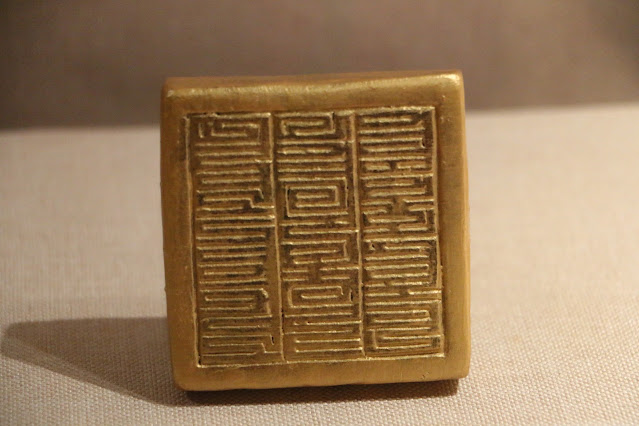There are several levels in the museum, and allow a couple of hours to see everything. I especially liked the costumes, and the snuff bottles, the shaman history, and the wooden puzzle history. I also learnt a lot about Mongolia.
Snuff bottles are made from an assortment of materials. Wood, ivory, Coral, turquoise, silver, shell, porcelain, brass, and rock crystal.
The exchange of snuff bottles was one of the most important gestures of traditional welcome.
The top of the snuff bottle plays an important role in determining it's value.
Jade snuff bottles with coral tops.
The snuff bottle usually hangs from the belt, in it's own pouch, made of embroidered silk.On the next floor of the museum, was a collection of objects that were interesting to me. Seal of the Military commander. A wooden board game (replica) that dates back to Chinggis Khaan's time in Kharakhorum. (13th Century).
Three-pointed steel fork of Tsagaan Suld (White Banner). The symbol of great power, as well as independence and unity. History states that Chinggis Khaan united the steppe nomads and gathered them by the river Onon. He created the Nine White Flags. The flags consisted of the primary flag, and the eight accompany flags. They were made from the mane of white horses, hence the name the White Banners or the white flags. The three pointed flame shaped steel fork is a symbol of eternity.
Shaman costume
Shamanism is one of oldest religions and beliefs in Mongolia. It has been developed on the basis of the belief in totemism or animism and dated back to 300 to 400 BC. The Huns, ancestors of Mongols, worshiped shamanism and it was the main religion of Hun Empire. The word shaman (böö / бөө) is a common noun that can be divided in two categories: a male shaman (büge / бөө / зайран) and a female shaman (idugan / удган). Hun and Mongol people worshiped the sun and the moon, and made sacrificial offerings to the heavens, the earth, spirits, and their ancestors.Mongolian shamanism is an all-encompassing system of belief that includes medicine, religion, a reverence of nature, and ancestor worship. Central to the system are the activities of male and female intercessors between the human world and the spirit world, shamans (böö) and shamanesses (udgan). An important attribute for Mongolian shamans is shared with all other shamanisms of Inner Asia: the drum. Mongolian shaman drums may incorporate the shaman's ongon or ancestral spirit, where the drum handle represents that ongon.
The main rite of Mongolian shamanism is to worship and sacrifice heaven. Shamanism venerates the blue sky and green earth. Mongolian shamanism has 55 deities (Tenger or Tengri) of the west who are well disposed towards humans and 44 deities (Tenger or tengri) of the east who cause all misfortunes. Mongolian Shamanism worships 99 deities, in total. These deities protect the clans or tribes, including individual persons, before the power of nature. In Mongolian shamanism, there are water spirits (lus), and mountain spirits (savdag), as well as souls and amulets.
Shaman's costume - Cloth, silk, metal, wood, eagle feather.
The Mongolians appear to have a lot of board games.
Wooden puzzles. Mongolians invented them.
Some other things caught my eye.
Decorated saddle from the 19th Century.
Leather and wood flask. A common accessory for the nomadic horsemen carrying distilled beverage.
The airag (fermented horse milk) bags are made of cow's hide. First the hide is smoked and softened and after it is sized, cut and sewed. The bottom of the bag is broad and the mouth side, or th supper part is narrow. The upper two ends of the bag contain strings that support it to be hanged on the walls and convenient for transport. I hope to try some airag over the next week, on the cycling tour of Mongolia.
Birch bark container used to store airag milk products. (fermented horse milk)
Silk and leather Deel of the Sükhbaatar, the Chief commander 1922.
Seal of Bat Khuleg Tugs Dalai Khan who governed the eastern region of Durvüd. Silver 1913.
Mongolian cosmonaut gear of J Gurragchaa 1981
Russian traditional drinking vessel set "Kovsh". Brass, enamel and precious stones 1925
Bronze Mongolian border marker.






























No comments:
Post a Comment